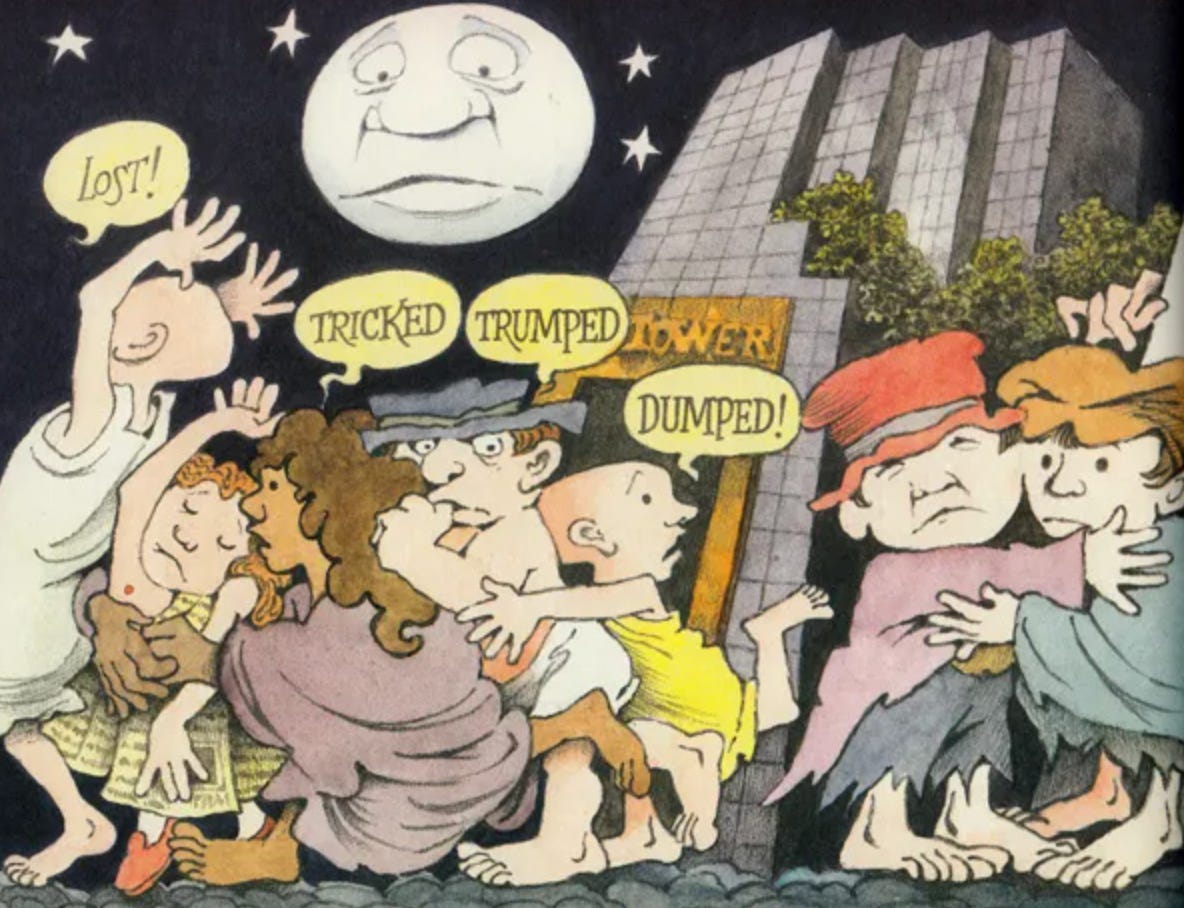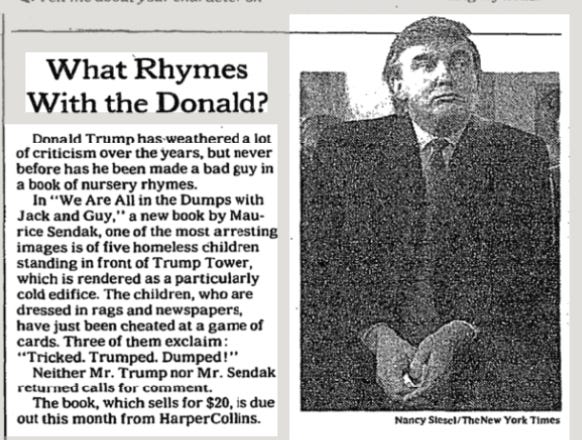
Epstein and Trump post at Mar-a-Lago in 1997.Davidoff Studios/Getty Images
This story was originally published by Popular Information, a substack publication to which you can subscribe here.
This past Thursday, the Wall Street Journal published a bombshell report about President Trump’s relationship with convicted child sex abuser Jeffrey Epstein. According to the Journal, the materials collected as part of the Department of Justice’s investigation into Epstein included a 2003 birthday message from Trump to Epstein.
Trump’s alleged message consists of “several lines of typewritten text framed by the outline of a naked woman, which appears to be hand-drawn with a heavy marker.” The drawing, which the Journal describes as “bawdy,” includes “[a] pair of small arcs denotes the woman’s breasts, and the future president’s signature is a squiggly “Donald” below her waist, mimicking pubic hair.” Inside the figure of the woman was the following text:
Voice Over: There must be more to life than having everything
Donald: Yes, there is, but I won’t tell you what it is.
Jeffrey: Nor will I, since I also know what it is.
Donald: We have certain things in common, Jeffrey.
Jeffrey: Yes, we do, come to think of it.
Donald: Enigmas never age, have you noticed that?
Jeffrey: As a matter of fact, it was clear to me the last time I saw you.
Donald: A pal is a wonderful thing. Happy Birthday — and may every day be another wonderful secret.
Trump told the Journal that the letter is “fake” and quickly sued the paper, its owner Rupert Murdoch, and the two reporters who wrote the story for $10 billion. On Truth Social, Trump insisted that the letter is “not the way I talk.”
Meanwhile, numerous allies of the president have echoed this claim, arguing that the letter is inauthentic because its language does not sound like Trump.
“Does anyone honestly believe this sounds like Donald Trump?” Vice President JD Vance asked rhetorically on X. White House Press Secretary Karoline Leavitt said the letter published by the Journal is “not at all how he speaks or writes.” Trump’s eldest son, Donald Trump Jr., said it is obvious the letter is inauthentic because it doesn’t match his father’s “very specific way of speaking.”
To evaluate these claims, Popular Information examined the most distinctive aspects of the letter and assessed whether they are consistent with Trump’s history.
“Enigma“
The most distinctive single word in the letter is “enigma.” Is it plausible that Trump, known for using simple language, would use that word?
Trump’s defenders do not believe so. “I find it to be an enigma that Donald Trump would use the word enigma,” billionaire Bill Ackman, a prominent Trump supporter, wrote on X.
Sean Davis, the CEO of the right-wing publication The Federalist, posted that he asked Grok, the chatbot created by xAI, to “search every record of Trump speaking or writing” for the word “enigma” and determined “there is no record of him ever saying or speaking the word.” (Trump Jr. reposted Davis’ claim.)
Davis’ confident assertion is false and demonstrates the hazards of relying exclusively on AI tools for research. In 2015, Trump used the word “enigma” twice to describe Ben Carson, one of his Republican primary opponents. “Now, Carson’s an enigma to me,” Trump said. “Carson’s an enigma.”
Trump also used the word “enigma” twice in his 2004 book, Trump: How to Get Rich. “Dan Rather is an enigma to me,” Trump wrote on page 166. He uses enigma again on page 55, writing that entrepreneurial skills are “one of those grey areas that remain an enigma even to those with finely-honed business instincts.”
Trump also used the term in his 1990 book, Trump: Surviving at the Top. “Any discussion of Mike’s affairs eventually leads to the subject of Don King,” Trump wrote about Mike Tyson on page 200. “Don, like Mike, is something of an enigma.”
So, while enigma is not a commonly used word, it is one that Trump has deployed in a variety of contexts for many years.
“Pal“
The word “pal,” which appears at the end of the letter to Epstein, is somewhat old-fashioned and less commonly used than the more straightforward term “friend.” Trump, however, has used “pal” over the years to describe his close associates.
In a 2018 roundtable on tax reform, Trump talked about his friendship with Steve Witkoff, who is currently Trump’s special envoy to the Middle East. “He’s become a very wealthy, successful man,” Trump said. “And he’s my pal.”
During a 2011 speech to the Nevada Republican Party, Trump referred to developer Phil Ruffin as “my pal.”
Maurice Sendak
Perhaps the most distinctive characteristic of the letter is the opening line: “There must be more to life than having everything.” This is a direct quote from Higglety Pigglety Pop!, a classic 1967 book by children’s author Maurice Sendak. It comes off like an inside joke between the two men.
Sendak and Trump have a history. In 1993, Sendak published We Are All in the Dumps with Jack and Guy. The book, which stirred controversy due to its exploration of weighty topics such as the AIDS crisis, garnered extensive coverage in the national media, including the New York Times, the Los Angeles Times, and the Palm Beach Post—the local paper for Mar-a-Lago.
It also featured a direct attack on Trump, with one illustration featuring homeless children against the backdrop of Trump Tower. The children exclaim, “Tricked. Trumped. Dumped!”

A September 5, 1993, story in the New York Times highlights Sendak’s criticism of Trump. The reporter, Degen Pener, said he reached out to Trump for comment. (Trump did not respond.)

Trump is a voracious consumer of media, especially when it involves him, so he almost certainly would have read the coverage of Sendak’s book. The fact that the New York Times, a paper Trump follows closely, reached out to him increases those odds further.
The timing of the incident, 1993, coincides with a period during which Epstein and Trump were known to socialize together regularly.
Third person
Another distinctive feature of the letter is that it creates a fake dialogue between Trump and Epstein, in which Trump refers to himself in the third person.
Trump frequently refers to himself in the third person. A Washington Post analysis of this habit, published in 2019, refers to Trump as the “third-person-in-chief.”

Trump also enjoys recounting conversations between himself and another person. Many of these tales are apocryphal. For example, during a June 2020 rally, this is how Trump relayed a conversation between himself and First Lady Melania Trump after Trump was filmed having difficulty drinking from a glass of water:
I call my wife, I said, “How good was that speech? I thought it was a…” But I call my wife and I said, “How good was it, darling?”
She said, “You’re trending number one.”
I said to our great first lady, I said, “Let me ask you a question. Was it that good, the speech, that I’m trending number one? Because I felt it was really good.’”
“No no, they don’t even mention the speech. They mention the fact that you may have Parkinson’s disease.”
So, so then my wife said, “Well, it wasn’t only the ramp. Did you have water?”
I said, “Yeah. I was speakin’ for a long time. I didn’t wanna drink it, but I wanted to wet my lips a little bit, you know?” … So what happens is I said, “What does it have to do with water?”
They said, “You couldn’t lift your hand up to your mouth with water?”
I said, ‘I just saluted 600 times like this, and this was before I saluted, so what’s the problem?
The same speech involved Trump narrating extended conversations between himself and the CEO of Boeing, as well as with an unnamed general. In other words, the form of the letter is consistent with one of Trump’s favorite rhetorical devices.
The “picture”
Trump also claimed the letter was fake because it featured a picture drawn by Trump, and “I don’t draw pictures.”
In fact, Trump has drawn many pictures, frequently using a “heavy marker,” just as the Journal described the Epstein letter. The pictures were sometimes auctioned for charity.

He also discusses his artistic talents (and uses the third person) in his 2008 book, Trump Never Give Up: How I Turned My Biggest Challenges Into Success.
“It takes me a few minutes to draw something, in my case, it’s usually a building or a cityscape of skyscrapers, and then sign my name, but it raises thousands of dollars to help the hungry in New York through the Capuchin Food Pantries Ministry,” Trump wrote.


